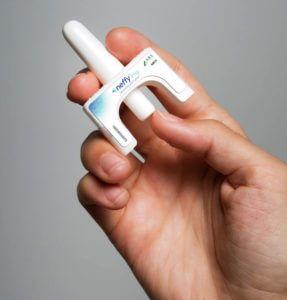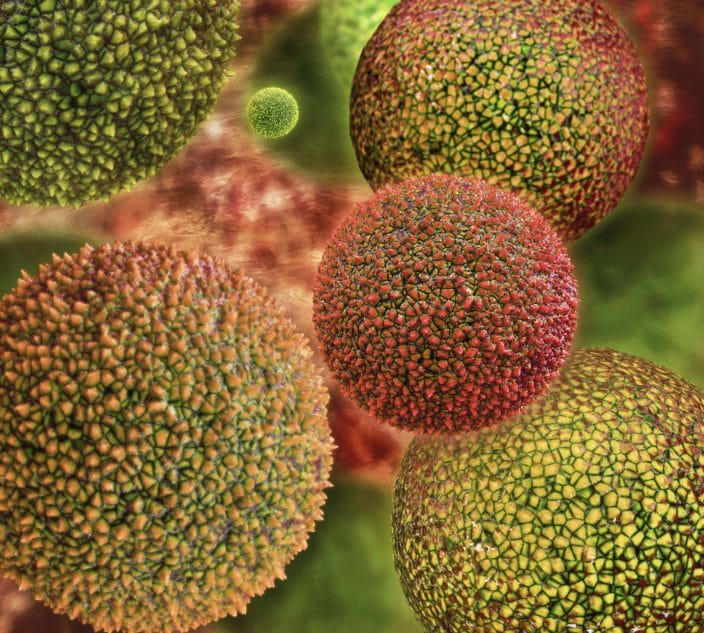The nasal epinephrine sprayer called neffy reversed anaphylaxis in 15 children experiencing a serious reaction to a food allergen.
The new data is the first to show how neffy works during real-world food allergy reactions. The children included in the study were taking part in oral food challenges at their doctor’s office when they experienced anaphylaxis.

“One hundred percent of the patients responded to a single dose, which is great,” says Dr. Thomas Casale. He’s chief of Clinical and Translational Research at University of South Florida’s Division of Allergy and Immunology. “They all responded very rapidly, and they all had a complete resolution of their symptoms.”
The trial, conducted in Japan, is one of several new studies released by neffy’s developer, ARS Pharmaceuticals. Another was a small trial showing that the nasal epinephrine spray reduced hives and itch in adults experiencing a flare of chronic urticaria. These studies were presented at the 2024 American Academy of Allergy Asthma and Immunology (AAAAI) meeting in Washington, D.C.
Ahead of the allergists’ meeting, the company also shared topline data on its “repeat dosing” study in people with nasal congestion. This is a study the Food and Drug Administration requested as a condition of approval consideraton.
If the FDA does approve the novel sprayer, neffy would become the first, non-needle alternative to epinephrine auto-injectors.
Halting Serious Reactions
The children in the anaphylaxis study were undergoing oral challenges, supervised by a doctor, when their reactions occurred. The challenges are tests in which progressive amounts of an allergen are eaten to determine how much can be tolerated.
The children, ages 6 to 17, received the epinephrine spray as soon as their symptoms were considered “moderate” anaphylaxis. Symptoms could include widespread hives, a swollen face or throat pain, significant stomach pain, coughing, chest tightness, wheezing, rapid heart rate, a mild drop in blood pressure, or a feeling of impending doom.
All of the children started getting better within 5 minutes of receiving one dose of the nasal spray. Their symptoms were gone or nearly gone at about 16 minutes, on average.
That time to symptom resolution is similar to what you’d expect with an auto-injector, says Casale, an adviser to ARS Pharma and a past president of the AAAAI. “With an auto-injector you would see very similar types of responses.”
Nasal Spray’s 1st Real-World Data
The new study is small, but “very reassuring,” Casale says. In the United States, regulators consider it too risky to do trials on new epinephrine products, such as neffy, in people having anaphylactic reactions.
So U.S. trials with neffy have been done in healthy volunteers. The studies measure blood levels of epinephrine after the nasal spray, and increases in heart rate and blood pressure. These indicate epinephrine absorption.
“One of the things that physicians want to know is, ‘if I need this, is it really going to work?’” he says. “It’s great to have blood levels, but you want to make absolutely sure it’s going to work the way it should.”
The study on neffy in the kids with anaphylaxis was conducted at the request of regulators in Japan. Such a trial might be conducted in the U.S. after FDA approval, but not before, Casale says.
Children received either the 1 milligram or 2 mg dose of the neffy nasal spray, depending on their body weight.
None needed a second dose. However, one child experienced a biphasic reaction nearly three hours later and was treated with epinephrine using a syringe.
Relief for Chronic Hives
In a second study, Casale and colleagues tested neffy in patients experiencing a flare of hives due to chronic urticaria. The condition causes allergic-like reactions, in that various triggers set off an immune system response involving the release of histamine and other chemicals. This results in hives, itch and sometimes swelling.
Within 5 minutes of receiving either the 1 mg or 2 mg nasal spray, the patients’ hives began to subside. Relief lasted for at least two hours. Patients given a placebo nasal spray did not show similar improvements.
The trial is more real-world evidence for neffy, Casale says. “Urticaria is one of the key signals of an anaphylactic reaction.… This was a demonstration of proof of principle that it works.”
2 Doses of Nasal Spray Study
On February 20, ARS Pharma also shared topline data from a study looking at two doses of the nasal spray in people with nasal congestion due to allergic rhinitis. The FDA requested this study after it declined to approve neffy in September 2023.
The trial included 43 healthy adult participants with nasal congestion (not anaphylaxis). Researchers sprayed purified antigen (allergen) into their noses. This is called a nasal challenge and is considered “worst-case” nasal congestion, says Richard Lowenthal, president and CEO of ARS Pharma.
Participants had two doses of the epinephrine spray, spaced 10 minutes apart, either in the same nostril or in alternate nostrils. Two doses of neffy resulted in greater heart rate and blood pressure changes than two doses of epinephrine given by syringe.
Dosing in the same nostril may be better than alternating. Two doses of neffy in the same nostril led to greater blood pressure and heart rate changes than dosing once in each nostril. Using the same nostril for both doses also led to higher concentrations of epinephrine in the blood than two epinephrine injections, at all time points.
Using different nostrils for two doses led to higher blood concentrations than two shots of epinephrine from a syringe until 30 minutes. After 30 minutes, epinephrine in the blood was higher with two syringe doses.
“We are very pleased with the topline results from our repeat dose study of neffy under nasal allergen challenge conditions, which we believe will address FDA’s requests … and support the approval of neffy,” Lowenthal says.
The FDA also asked the company to test for nitrosamine in the medication. No measurable levels were detected.
Will the FDA Approve?
In May 2023, an FDA advisory committee made up of allergists and other experts had recommended that the agency approve the 2 mg epinephrine spray for children and adults weighing 66 pounds or more.
The FDA usually follows the advice its advisory committees, but didn’t with neffy. In declining to approve, the FDA specifically requested the two-dose study with nasal congestion.
Lowenthal has told Allergic Living that he and his team were shocked by the FDA’s demand for this study before approval consideration. He said the company had earlier agreed with FDA staff to undertake a repeat dose study, but as a study conducted after approval.
However, with the results in, Lowenthal says they “demonstrate that the epinephrine exposures achieved with repeat doses of neffy fully activate the receptors involved in reversing anaphylaxis symptoms.” ARS Pharma will submit the final study results to the FDA in the next few months.
ARS Pharma is also developing the 1 mg nasal spray for kids weighing between 33 and 66 pounds. It has not yet applied for FDA approval for that sprayer.
Nasal Epi Spray Meets Heat
Another study found that neffy can withstand higher temperatures for longer periods than epinephrine in an auto-injector.
The study compared the potency of neffy to two brands of auto-injector brands, EpiPen and Symjepi, after being stored at 122 degrees Fahrenheit for three months and 104 degrees Fahrenheit for six months.
After three months at 122 degrees, Symjepi had lost nearly 57 percent of its potency, EpiPen lost almost 42 percent, while neffy was down less than 9 percent.
After six months at 104 degrees, EpiPen was down 27.5 percent, Symjepi was down 17 percent and neffy had lost 14 percent of its potency.
“Neffy was more stable than injection products,” the study concluded. “EpiPen and Symjepi showed rapid and extensive degradation … at these extreme temperature conditions after a short period of time.”
The expiration period for auto-injection products is 18 months, while neffy will likely have a 24-month shelf-life, according to ARS Pharma. “You don’t have to worry as much about nasal epinephrine breaking down,” Casale says. However, “you don’t want to bake it on the dashboard of your car in the middle of the summer.”
What Doctors, Patients Say
The company also conducted surveys of physicians, patients and caregivers on epinephrine devices. Ninety percent of doctors said patients would be more likely to use the device because it doesn’t require an injection, and 86 percent believed they would use the device more quickly in a reaction.
About 79 percent of doctors felt patients would be more likely to carry the nasal epinephrine spray than an auto-injector because of the smaller size. The survey included 315 allergists, pediatricians and primary care doctors.
A survey of 480 patients and families of children with allergies found that 77 percent said they were more likely to use a nasal spray after symptoms start. As well, 89 percent said they were more likely to carry it.
“There is no reason to believe neffy is going to give you a superior result from the auto-injectors,” notes Casale. “It’s just that it provides a needle-free option which a lot of people are looking forward to because of the reluctance to use a needle.”
Related Reading:
Anaphylaxis but No Epinephrine: An Epidemic of Hesitation
Expert Panel Recommends FDA Approve Neffy Nasal Spray
All About Epinephrine: Allergic Living’s Guide





